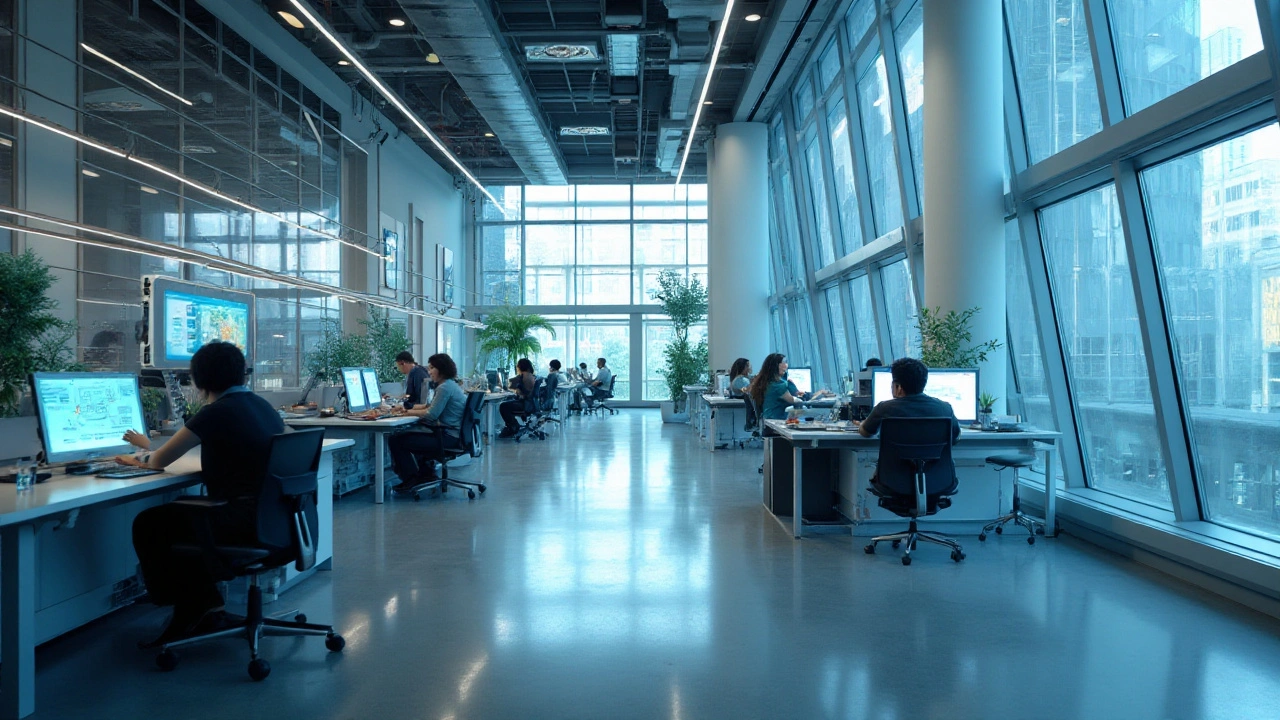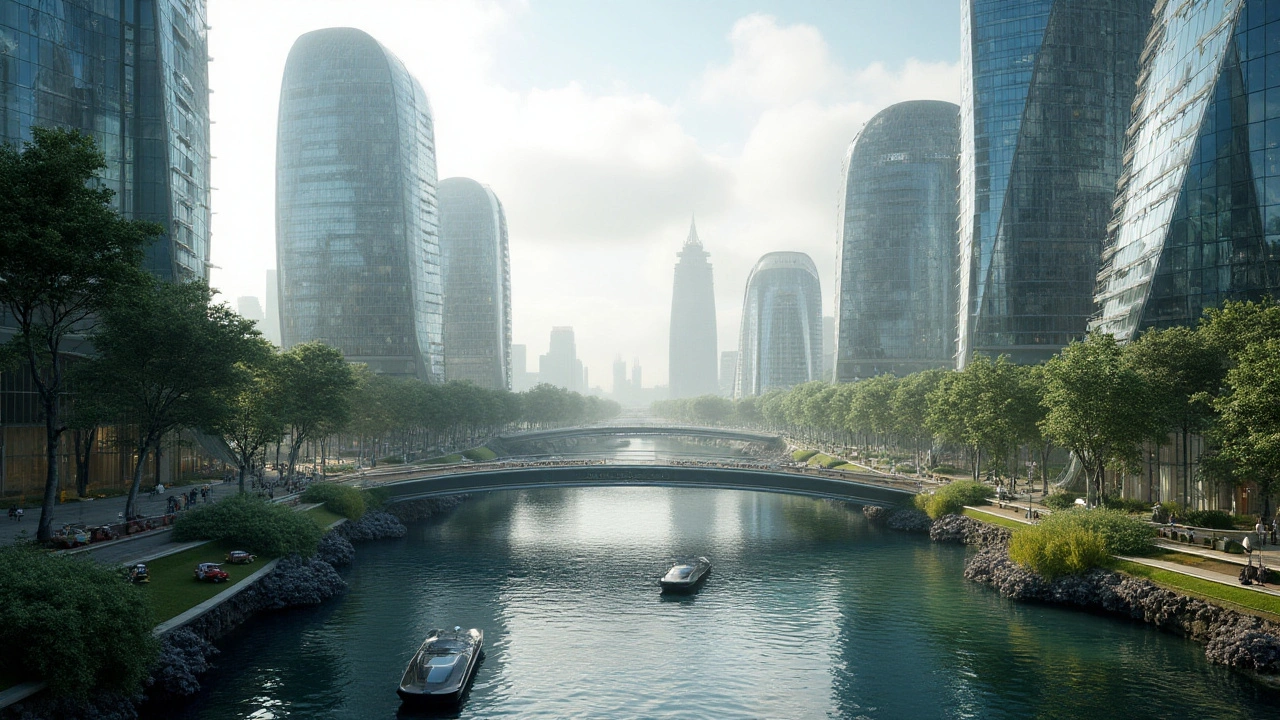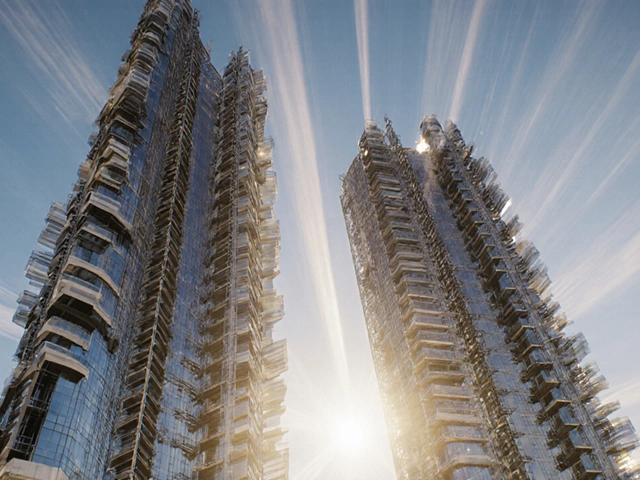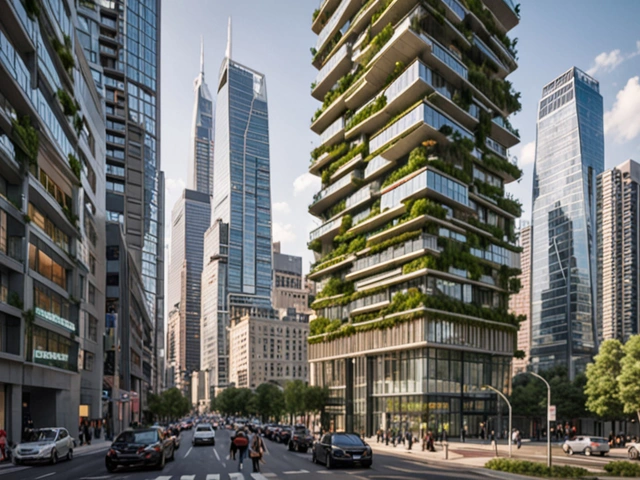High-tech architecture represents a thrilling fusion of advanced technology and eye-catching design. This style emphasizes transparency, flexibility, and the visible display of structural elements, often producing buildings that are just as functional as they are beautiful.
Originating in the late 20th century, high-tech architecture responds to a growing need for urban spaces that accommodate rapid technological advancements and greater environmental awareness. These structures often showcase innovative use of materials like steel, glass, and concrete, pushing the boundaries of what buildings can achieve.
- The Evolution of High-Tech Architecture
- Key Features of High-Tech Buildings
- Pioneers and Iconic Structures
- Sustainability and Environmental Impact
- Innovations and Future Directions
- Practical Tips for Incorporating High-Tech Elements
The Evolution of High-Tech Architecture
High-tech architecture has its roots in the post-World War II era, a time of remarkable industrial and technological advancement. Architects and engineers were inspired by the vast potential that new materials and construction methods presented. This period spurred a departure from traditional designs, with professionals seeking to emphasize the aesthetic appeal of structural and mechanical elements.
The movement officially took hold in the 1970s, with pioneers like Norman Foster and Richard Rogers leading the charge. Their work epitomized the goals of high-tech design: transparency, flexibility, and the celebration of a building's core functionalities. One of the most iconic examples from this period is the Centre Pompidou in Paris. With its exposed steel skeleton and vibrant color-coded service elements, it was a bold departure from conventional architectural norms.
High-tech architecture's hallmark is its visible display of structure and services. Instead of hiding pipes, ducts, and elevators, these elements are deliberately showcased. This has created a sense of honesty in building design, making it evident how a structure operates. Renzo Piano, co-designer of the Centre Pompidou, observed, "Architecture is about giving form to the places where people live. It is not more complicated than that, but it is also not simpler than that."
During the 1980s and 1990s, high-tech architecture continued to evolve. More innovative buildings emerged, like the Lloyd's building in London. Designed by Richard Rogers, this skyscraper illustrates how high-tech architecture reimagines urban landscapes. With its stainless steel cladding and externalized services, the building is both a functional workspace and an architectural statement.
The advancements in technology that began in the late 20th century only propelled high-tech architecture further. Computer-aided design (CAD) transformed how architects conceived and executed their ideas. This period saw the rise of parametric design, allowing for complex geometries and innovative forms that were previously unimaginable. The use of sustainable materials also began to gain traction, aligning with the growing environmental consciousness of the time.
Moving into the 21st century, high-tech architecture seamlessly integrated digital technologies like smart systems and Building Information Modeling (BIM). These advancements have made it easier to optimize buildings for energy efficiency, comfort, and adaptability. Contemporary high-tech structures often feature photovoltaic panels, advanced insulation, and even adaptive façades that respond to environmental conditions.
The Gherkin in London, designed by Norman Foster, serves as an exemplary high-tech skyscraper for the modern age. Its aerodynamic shape reduces wind load, and its double-skin façade improves natural ventilation, making it a model for sustainable high-tech design.
Today, high-tech architecture is not just about aesthetics; it’s about creating smart, sustainable spaces that respond to human needs and environmental responsibilities. The journey of high-tech architecture shows a dynamic interplay between technological progress and architectural creativity, continuously pushing the boundaries of what our built environment can achieve.
Key Features of High-Tech Buildings
High-tech architecture sets itself apart through several defining characteristics, making each structure a marvel of modern design. At its core, this style emphasizes transparency and bold visual elements. One of the most distinctive features is the visible exposure of structural and functional components. Instead of hiding pipes, ducts, and beams, these elements are integrated as part of the architectural expression. It's a celebration of how buildings work.
Steel, glass, and concrete are the primary materials used in high-tech architecture. Steel offers strength and flexibility, while concrete provides durability. Glass is utilized extensively, fostering a sense of openness and allowing natural light to flood in. This not only brightens the space but also reduces the need for artificial lighting, contributing to energy efficiency.
Another significant aspect is the emphasis on modular construction. High-tech buildings often use prefabricated components that can be easily assembled on-site. This approach speeds up construction and ensures high precision, which is crucial when dealing with sophisticated designs. It also opens the door to customization, allowing each project to meet unique requirements.
Technology integration is at the heart of high-tech architecture. These buildings are equipped with advanced systems for climate control, lighting, and security. There is a growing use of smart technology, with sensors and automated systems optimizing the building's performance in real-time. This not only improves comfort for occupants but can also lead to significant cost savings.
Sustainability is a core principle in high-tech architecture. Many of these structures are designed with environmental considerations in mind. They often incorporate green roofs, rainwater harvesting systems, and solar panels. As a result, these buildings minimize their ecological footprint while maximizing efficiency. It's about creating spaces that are not only stunning but also responsible and forward-thinking.
Flexibility and adaptability are also key features. High-tech buildings are designed to evolve and adapt to changing needs. Interior spaces can be easily reconfigured, ensuring they remain functional over time. This versatility is particularly valuable in urban environments, where space is at a premium, and demands can change rapidly.
"High-tech architecture pushes the envelope by merging aesthetic dynamism with technological innovation. It’s where engineering meets art," says renowned architect Norman Foster.
Another notable feature is the use of lightweight materials and structures. This not only reduces the load on foundations but also allows for more daring and imaginative designs. It's a balance of form and function, creating spaces that are as inspiring as they are practical.
The use of color and unconventional forms also plays a big role. High-tech buildings often feature bold colors and shapes, breaking away from traditional architectural norms. This adds to their distinctive character and ensures they stand out in any skyline.
In summary, the key features of high-tech architecture reflect a blend of artistic vision and cutting-edge technology. From visible structural elements to advanced building systems, each feature contributes to creating structures that are not only eye-catching but also efficient and sustainable. As urban needs continue to evolve, high-tech architecture remains at the forefront, shaping cities in innovative and exciting ways.
Pioneers and Iconic Structures
High-tech architecture's journey wouldn't be complete without mentioning its influential pioneers. Richard Rogers and Renzo Piano are often considered the forefathers of this movement, their work on Paris's Centre Pompidou in 1977 serving as an iconic launchpad. The building's 'inside-out' design, with its exposed skeleton of brightly colored pipes, ducts, and elevators, shocked and delighted observers, challenging conventional ideas of what an urban public space could look like.
Another notable figure in the world of high-tech architecture is Norman Foster. His work on the Willis Building in London and the HSBC Building in Hong Kong introduced radical design elements like external structural bracing and floor plans that facilitated natural ventilation and lighting. These concepts not only pushed architectural boundaries but also laid the groundwork for more sustainable building practices.
High-tech architecture also made waves in the United States. The Lloyd's Building in London, designed by Richard Rogers, often called the 'Inside-Out Building,' stands as a hallmark of this approach. Its futuristic design features external lifts and staircases, presenting a mechanical aesthetic that is both functional and visually captivating.
"We wanted to create a highly flexible and adaptable space that could respond to the changing needs of the office and the city," Norman Foster once said about his design philosophy.These words resonate strongly with the ethos of high-tech architecture, which often seeks to make buildings not just structures, but dynamic entities capable of evolving along with their surroundings.
Innovative design isn't confined to commercial spaces. Tokyo's Nakagin Capsule Tower, designed by Kisho Kurokawa, exemplifies the application of high-tech principles in residential architecture. Completed in 1972, the tower merged modular construction with advanced materials to create compact, functional living spaces.
Furthermore, Zaha Hadid, widely known as the ‘Queen of the Curve,’ embraced high-tech attributes in her designs. The London Aquatics Centre for the 2012 Olympics is a prime example, showcasing sleek lines and open spaces punctuated by extensive use of steel and glass.
In recent years, high-tech architecture has also embraced new technology to push boundaries even further. Santiago Calatrava’s Milwaukee Art Museum, with its moving sunshade, and the dynamic skin of the Al Bahar Towers in Abu Dhabi, which adjusts to sunlight, underscore the continued evolution of this style. These iconic structures serve as living symbols of what high-tech architecture can achieve, blending aesthetic appeal with intelligent design to create environments that are as livable as they are innovative.
Sustainability and Environmental Impact
High-tech architecture is not just about aesthetic appeal and innovative designs. One of its most significant contributions lies in its commitment to sustainability and minimizing the impact on the environment. Architects and designers in this field prioritize the use of eco-friendly materials and energy-efficient technologies, making these structures both forward-thinking and responsible.
A prime example of this commitment is the Bullitt Center in Seattle, often touted as the greenest commercial building in the world. It boasts a range of sustainable features, including a solar array that generates more electricity than the building needs and a rainwater collection system that supplies all its water needs. This building illustrates how high-tech architecture can lead the way in green building initiatives.
One crucial aspect of sustainable high-tech architecture is the reduction of carbon footprints. Many modern buildings achieve this through the use of recycled or locally sourced materials, which reduces the energy expended in transportation and production. Additionally, architects often incorporate green roofs and vertical gardens to enhance insulation and promote biodiversity in urban settings.
Energy efficiency also plays a pivotal role in high-tech architecture. Innovations such as smart glass, which controls the amount of light and heat entering a building, and advanced HVAC systems, which optimize energy usage, are now standard in many high-tech buildings. These technologies ensure that buildings use less energy, thereby reducing their environmental impact.
"Sustainability is no longer about doing less harm. It's about doing more good." – Jochen Zeitz
Water conservation is another hallmark of sustainable high-tech architecture. Structures often incorporate systems for rainwater harvesting and greywater recycling, reducing reliance on municipal water supplies. The use of dual-flush toilets and low-flow fixtures further minimizes water consumption within these buildings.
The overall goal of integrating these sustainable practices is to create spaces that not only serve their occupants but also harmonize with the natural environment. This holistic approach ensures that high-tech buildings contribute positively to urban landscapes, enhancing quality of life and maintaining ecological balance.

Innovations and Future Directions
The realm of high-tech architecture is continually evolving, bringing with it groundbreaking technologies and design philosophies poised to reshape our urban landscapes. One of the most thrilling innovations is the integration of smart technologies into buildings. This includes systems that manage lighting, heating, and even security optimally by learning the preferences and behaviors of occupants. Imagine walking into a building where the temperature adjusts itself automatically to your comfort level, or where energy consumption is minimized without any manual intervention.
Another exciting innovation is the use of sustainable materials and construction methods. Green roofs, solar panels, and wind turbines are becoming staples in high-tech architecture. These elements not only reduce the building's carbon footprint but also contribute to a healthier urban environment. Materials such as self-healing concrete and graphene-infused composites are being explored for their durability and reduced maintenance costs. These advancements help in creating sustainable structures that are both eco-friendly and economically viable.
Advanced construction techniques like 3D printing and modular construction also play a significant role in the future of high-tech architecture. These methods allow for quicker, more efficient building processes, often at a reduced cost. For instance, entire sections of buildings can now be printed or assembled off-site and then transported to their final destination. This reduces waste and speeds up the construction timeline significantly, making it a popular choice for modern buildings.
"High-tech architecture is not just about creating visually stunning buildings; it's about enhancing the quality of life for the people who use them," says Richard Rogers, a prominent architect known for pioneering this style.
Looking ahead, the integration of artificial intelligence (AI) and machine learning into building operations is expected to rise. AI can predict maintenance needs, optimizing the lifecycle of building systems and preventing failures before they occur. Machine learning algorithms can analyze vast amounts of data to improve energy efficiency, anticipating needs and adjusting resources in real time. This kind of proactive management helps in maintaining an optimal living or working environment with minimal human intervention.
The role of Virtual Reality (VR) and Augmented Reality (AR) in architectural design and construction is another field ripe with potential. These technologies offer immersive experiences that enable architects to visualize and tweak their designs in real time. Clients can virtually walk through a building before it's even constructed, providing an unprecedented level of input and customization. This not only enhances client satisfaction but also ensures that the final product aligns closely with the vision of its designers and users.
In terms of urban development, high-tech architecture is likely to pave the way for smart cities. These cities utilize integrated technologies to improve the quality of urban living. From smart traffic management systems to waste reduction initiatives, the impact of high-tech architecture extends beyond individual buildings to entire communities. This holistic approach aims for sustainability, efficiency, and resilience, ensuring that cities are well-equipped to handle future challenges.
As we move forward, it's essential to recognize that high-tech architecture is not just a trend but a crucial element in creating a sustainable and efficient future. By embracing technological advancements and innovative design principles, architects and urban planners can contribute significantly to building a world that is not only visually captivating but also environmentally responsible. So next time you walk past a modern building, take a moment to appreciate the layers of technology and thought that went into its creation.
Practical Tips for Incorporating High-Tech Elements
Incorporating high-tech elements into your architectural designs can transform a typical building into a modern masterpiece. The first step is to emphasize a blend of aesthetics and functionality. You want your designs to not only look good but also serve a purpose. This approach involves using cutting-edge materials like steel and glass, which can give your structures a sleek, modern look.
One effective way to start is by integrating smart technology. Smart windows, for instance, can adjust their tint based on the amount of sunlight, thereby reducing heating and cooling costs. These windows can connect to building management systems, offering both convenience and energy efficiency. Another advancement worth considering is the use of prefabricated components. Prefabrication can accelerate construction timelines and ensure greater precision compared to traditional methods.
Sustainability is another crucial aspect of high-tech architecture. Using environmental sensors, a building can monitor its own energy use and make adjustments in real-time. Employing eco-friendly materials, like recycled steel or low-emission concrete, can also reduce the building’s carbon footprint. Green roofs and vertical gardens can be included to enhance the aesthetics and further improve environmental benefits.
Lighting plays a significant role in high-tech architecture. Incorporating LED lighting systems controlled through IoT devices can drastically cut down energy consumption. These systems often come with customizable settings that can adjust the lighting based on the time of day or the activities being carried out, adding both efficiency and functionality.
As Frank Gehry once remarked, 'Architecture should speak of its time and place but yearn for timelessness.' High-tech architecture definitively encapsulates this idea.The use of modular furniture can also align with high-tech elements. Modular units can be easily rearranged and configured based on the changing needs of the occupants. This flexibility is a hallmark of high-tech design and is increasingly in demand in both residential and commercial spaces.
Harnessing Renewable Energy
Renewable energy sources such as solar panels and wind turbines can be integrated seamlessly into the building design. These energy solutions not only provide power but also serve as visual indicators of the building's commitment to sustainability. For example, solar panel facades can add a layer of sophistication while contributing to energy needs.Finally, incorporating advanced security features will ensure the building's safety. Modern security systems include biometric scanners, facial recognition, and smart locks. These technologies provide higher levels of security and can be integrated without compromising the design aesthetics.
In summary, by prioritizing smart technology, sustainability, and flexibility, you can design buildings that are bold, beautiful, and brilliantly efficient. High-tech architecture offers limitless possibilities, and adopting these practical tips can help you stay ahead in this ever-evolving field.





